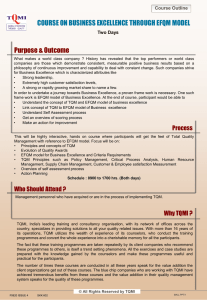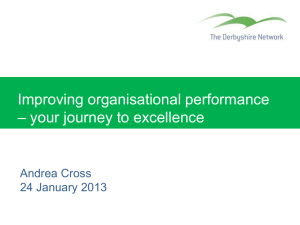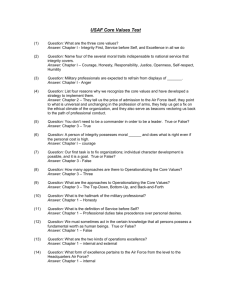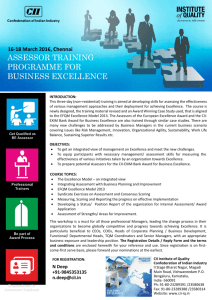Conference Positive Management 2015
advertisement
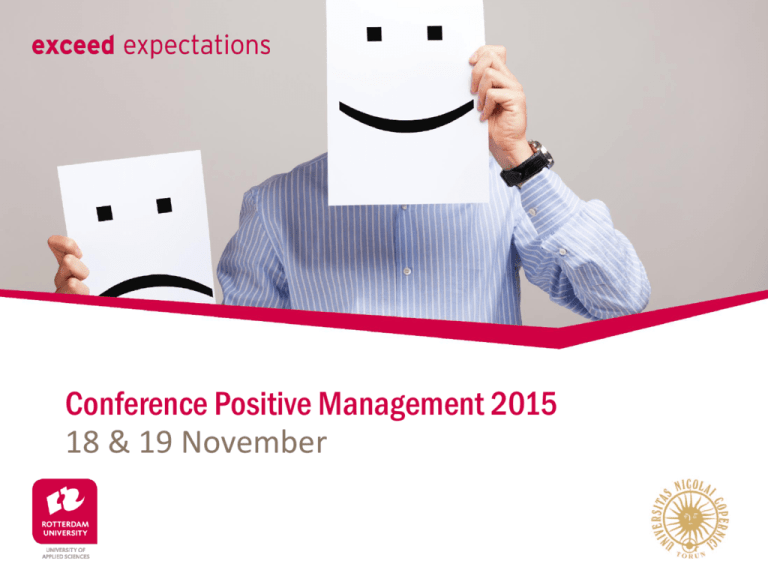
Conference Positive Management 2015 18 & 19 November Programme Financial Management; Chair: Dr. Maaike Lycklama à Nijeholt, Associate professor RUAS 08.30 Presentations of the Financial Management Research Group, RUAS Best Practices of Soft Controls, Omid Alozai Social Impact Bonds, Brian van Es The Soft Due Diligence Check: Success and Failure. Sybe Stuij 09.45 break 10.15 Positive Antecedents and Consequences of Entrepreneurship – Theoretical Considerations, Prof.dr. Przemyslaw Zbierowski 10.40 I like you and you like me, let's do something creative, Dr Aldona Glinska-Newes 11.05 break 11.30 Positive Employee Attitudes as a Determinant of Project Success and Business Excellence: The Case of Poland, Dr. Rafal Haffer, Dr. Joanna Haffer 12.00 Finding meaningfulness In-Work: why sensitivity matters, Donna Morrow 12.30 luncheon Conference Positive Management 2015 18 & 19 November POSITIVE EMPLOYEE ATTITUDES AS A DETERMINANT OF PROJECT SUCCESS AND BUSINESS EXCELLENCE: THE CASE OF POLAND JOANNA HAFFER, PhD TORUN SCHOOL OF BANKING, FACULTY OF FINANCE AND MANAGEMENT, DEPARTMENT OF MANAGEMENT PROF. RAFAŁ HAFFER NICOLAUS COPERNICUS UNIVERSITY, FACULTY OF ECONOMIC SCIENCES AND MANAGEMENT, DEPARTMENT OF BUSINESS EXCELLENCE 3RD EUROPEAN CONFERENCE ON POSITIVE MANAGEMENT, ROTTERDAM 2015 PRESENTATION ISSUES 4 Research projects introduction Project 1: business excellence of companies Characteristics of the EFQM Excellence Model Research results: progress of Polish enterprises towards business excellence and critical improvement factors Project 2: project management efficiency Definition of project success factors Research results: project success factors in Polish companies Conclusions 3RD EUROPEAN CONFERENCE ON POSITIVE MANAGEMENT, ROTTERDAM 2015 RESEARCH PROJECTS INTRODUCTION 5 The presented data come from two research projects The first one, entitled „Self-assessment in quality management systems of companies” (grant of the Polish Ministry of Science and Higher Education, no. 1 H02D 099 30) was concerned with the engagement of Polish enterprises in the initiatives aiming at business excellence It was completed in 2007 As a result, a sample PL2007 made up of 230 enterprises was examined The second research project entitled “Project management efficiency in the enterprises operating in Poland” was concerned with project success factors in companies It was conducted in 2008 The research resulted in purposive sample PL2008, mostly formed on the basis of the member list of the Polish Project Management Association. In total, 70 respondents participated in the study 3RD EUROPEAN CONFERENCE ON POSITIVE MANAGEMENT, ROTTERDAM 2015 PROJECT 1: BUSINESS EXCELLENCE OF ENTERPRISES 6 The representatives of top management were asked in a structured questionnaire to evaluate on a 0-100 percentage scale the advance of the companies they manage in business excellence initiatives, regardless of whether they apply any of the holistic leadership models or not. EFQM Excellence Model indicators were used as the evaluation criteria for the study The measurement scales included 51 sub-criteria, constituting of nine more aggregated criteria identical with nine elements of the EFQM Excellence Model. According to these criteria, respondents could assess an organization’s progress towards excellence. These evaluations were then linked with a performance variable The results of correlations encouraged the discussion of the condition of Polish enterprises and made it possible to determine the efforts which should be made for their further development 3RD EUROPEAN CONFERENCE ON POSITIVE MANAGEMENT, ROTTERDAM 2015 PROJECT 1: THE EFQM EXCELLENCE MODEL = THE EUROPEAN QUALITY AWARD MODEL 7 3RD EUROPEAN CONFERENCE ON POSITIVE MANAGEMENT, ROTTERDAM 2015 8 3RD EUROPEAN CONFERENCE ON POSITIVE MANAGEMENT, ROTTERDAM 2015 Self-assessment results for EFQM Excellence Model indicators (PL2007) PROJECT 1: PROGRESS OF POLISH COMPANIES TOWARDS BUSINESS EXCELLENCE PROJECT 1: PROGRESS OF POLISH COMPANIES TOWARDS ORGANIZATIONAL EXCELLENCE Correlations r coefficients for EFQM Excellence Model indicators and performance variable (FTP) (PL2007) 9 EFQM Excellence Model indicators Firm’s total performance (FTP) Enablers according to EFQM Model Leadership 0.162* People management 0.180** Strategy 0.091 Partnership and resources 0.176** Processes 0.147* Results according to EFQM Model People results 0.242† Customer results 0.217† Society results 0.223† Key results 0.564† * p<=0.05; ** p<=0.01; † p<=0.001 3RD EUROPEAN CONFERENCE ON POSITIVE MANAGEMENT, ROTTERDAM 2015 PROJECT 1: CRITICAL IMPROVEMENT FACTORS FOR POLISH COMPANIES ON THEIR ROAD TOWARDS BUSINESS EXCELLENCE Results for individual items of the EFQM Model for PL2007 sample – performance-importance matrix 10 90 80 Performance 70 Feedback on improvement proposals submitted by employees Systematic measurement of satisfaction, loyalty, productivity and absenteeism Strategy is well known on of employees each level of organization The results of employee satisfaction survey are a current signpost for improvements Documented improvements in critical processes within the space of last three years 65 60 50 Increase of employee satisfaction Vision and mission of a company are well known among employees Employee satisfaction indicators are defined 40 Increase of the number of improvement proposals Individual development plans for every employee are created 30 0,2 0,3 0,4 Importance 0,5 3RD EUROPEAN CONFERENCE ON POSITIVE MANAGEMENT, ROTTERDAM 2015 0,6 PROJECT 1: CRITICAL IMPROVEMENT FACTORS FOR POLISH COMPANIES ON THEIR ROAD TOWARDS BUSINESS EXCELLENCE Results for individual items of the EFQM Model for PL2007 sample 11 Leadership Strategy documented improvements in critical processes within the space of last three years People results strategy is well known on each level of organization Processes vision and mission of a company are well communicated to all employees employee satisfaction indicators (the conditions which should be fulfilled to satisfy the employees) are defined systematic measurement of satisfaction, loyalty, productivity and absenteeism of employees using the results of employee satisfaction survey as the current signpost for improvements growing level of employee satisfaction growing number of improvement proposals submitted by employees People management individual development plans for every employee feedback on improvement proposals submitted by employees 3RD EUROPEAN CONFERENCE ON POSITIVE MANAGEMENT, ROTTERDAM 2015 PROJECT 2: THE EFECTIVENESS OF PROJECT MANAGEMENT 12 The project managers were asked in a structured questionnaire to verify a list of project success factors in order to assess their importance in a recently realized project, using the scale from 0 to 5, where: 0 meant that a given factor was insignificant for project success, 1 meant that a given factor had very little significance, 2 – little significance, 3 – medium significance, 4 – big significance, and 5 – very big significance for project success This way it was possible to identify factors increasing project management efficiency in enterprises operating in Poland 3RD EUROPEAN CONFERENCE ON POSITIVE MANAGEMENT, ROTTERDAM 2015 PROJECT 2: DEFINITION OF PROJECT SUCCESS FACTORS 13 Project success factors are the key variables explaining its success (Diallo, Thuiller, 2005) They can also be referred to as “lever” or “stimuli” which can be used by project managers or project organization to increase the probability of achieving the desired project result (Westerveld, 2003) Paying attention and caring about these factors improves the effectiveness of all project management processes 3RD EUROPEAN CONFERENCE ON POSITIVE MANAGEMENT, ROTTERDAM 2015 PROJECT 2: PROJECT SUCCESS FACTORS IN COMPANIES OPERATING IN POLAND Average assessment of the importance of individual groups of factors for project success (PL2008) 14 3RD EUROPEAN CONFERENCE ON POSITIVE MANAGEMENT, ROTTERDAM 2015 PROJECT 2: PROJECT SUCCESS FACTORS IN COMPANIES OPERATING IN POLAND A part of a list of 87 project success factors ordered according to their importance for project success (PL2008) 15 13 Factor connected with project manager 9 Factor connected with project team 1 X - 2 X - 3 - - 4 - X 5 X - 6 - X 7 X - 8 X - 9 - X 10 X - 11 - X 12 X - 13 - - 14 - X 15 - X 16 - X 17 X - 18 X - 19 - X 20 X - 21 - X 22 X - 23 - - 24 - - 25 - - 26 X - 27 X - 28 - - 29 - - No. 1 Factor connected with project Factor name implementing organization FACTORS CRITICAL FOR PROJECT SUCCESS – LIST OF 29 engagement of project manager sense of responsibility of project manager clearly defined project objectives (clear and understandable X project vision) engagement of project team members ability of project manager to react to changes sense of responsibility of project team members for project results communicative skills of project manager leadership skills of project manager professional / specialist competences of project team members formal and informal authority of project manager communicative skills of project team members skills of project manager in coordination of activities and works X atmosphere of cooperation proper composition of project team atmosphere stimulating creativity of project team members acceptance and good relations among team members speed of decision-making of project manager previous experience of project manager at a similar post clarity of division of responsibilities among team members knowledge and skills of project manager in project management motivation of team members ability of project manager to delegate powers X regular supervision of implementation of project plan easy access to suitable resources necessary for project X implementation X realistic project plan ability of project manager to reach compromise motivation of project manager X detailed and clear structure of division of duties within project agreement for active participation of customers (their X representatives) in project works / customer involvement 6 Factors connected directly with project Average mark 4.6 4.5 4.4 4.4 4.4 4.4 4.3 4.3 4.3 4.3 4.3 4.3 4.2 4.2 4.2 4.2 4.2 4.1 4.1 4.1 4.1 4.1 4.0 4.0 4.0 4.0 4.0 4.0 4.0 CONCLUSIONS 16 The research results made it possible to indicate how strongly performance on both the operational (project) level and the strategic (business) level is influenced by positive employee attitudes The key factors influencing examined firms’ performance, from among 51 tested according to the EFQM methodology, deal with people and their satisfaction. At the same time they are the most critical factors for business excellence improvement Similarly, among 87 tested factors which are conducive to successful realization of projects, the most significant ones are those referring to people, especially to their engagement 3RD EUROPEAN CONFERENCE ON POSITIVE MANAGEMENT, ROTTERDAM 2015 JOANNA HAFFER, PhD joanna.haffer@wsb.torun.com.pl PROF. RAFAŁ HAFFER rafalh@econ.uni.torun.pl THANK YOU FOR ATTENTION Meaningfulness in work: Why Sensitivity Matters Donna Morrow, MBA, PMP Doctoral Student, Satish & Yasmin Gupta College of Business, University of Dallas Sue Conger, PhD Professor, Satish & Yasmin Gupta College of Business, University of Dallas 2015 Positive Management Conference, Rotterdam, Netherlands Research Question and Working Definition • RQ: How best to define meaningfulness sensitivity in work? • Working definition -- ‘meaningfulness sensitivity in work is a heightened mindfulness toward finding significance or purpose in work.’ – To have meaningfulness in work, the work role is significant or has purpose (Pratt and Ashforth, 2003) – Mindfulness is the presence or absence of attention to and awareness of what is occurring in the present (Brown and Ryan, 2003) Meaningfulness in work • In work versus at work (Pratt and Ashforth, 2003) – In work focus is on the individual’s work role of aggregated job tasks – At work focus is on the organizational community where employees conduct work • Meaningfulness in work is a subjective state that (Pratt and Ashforth, 2003; Vuori et al., 2012) – Varies from individual to individual – Perception of significant and purposive positive meaning Importance of this research • In defining a new construct, companies can – Help meaningfulness-sensitive staff to design their jobs, increasing satisfaction and productivity – Assist less sensitive staff to develop more personal value in their work – Provide insight into ways to address cynicism and high attrition • Meaningfulness sensitivity research is lacking despite research that indicates – Meaningfulness in work increases employee retention and Vohs, 2002; Cartwright and Holmes, 2006) (Baumeister – Increases positive outcomes such as job satisfaction, job performance, and job motivation (Cameron and Spreitzer, 2012; Rosso et al., 2010; Shusha, 2014) – Decreases employee cynicism Springett, 2004) (Andersson and Bateman, 1997; Holbeche and Background • ‘How to generate meaningfulness’ is a positive management concern as employees can flourish when meaningfulness in work exists (Burke, 2015) • Meaningfulness in work is a positive outcome – Part of positive organizational scholarship (Pratt and Ashforth, 2003) – Growing research interest (Burke, 2015; Cameron and Spreitzer, 2012) Background continued • Mindfulness draws upon both Buddhist psychological underpinnings and empirical psychology scholarship • Identity theory posits role-related behaviors within social structures are the primary focus (Stryker, 1968) • Job Design can positively influence employees’ ability to function effectively at work (Wrzesniewski et al., 2013) Methodology • Level of analysis – Individual level • Grounded Theory (Glaser and Strauss, 2012) – No existing theory – No explicit expectations in order for theories to emerge • Approach – Interviews and Focus Groups – – – – 2 major airline companies 28 individual interview 2 focus groups White collar, managerial, executive participants • Bias mitigation – Triangulation, reflexivity, and bracketing Discussion/Implications • Academic – Extend positive management and meaningfulness in work research – Align our focus with the tenets of positive management while answering the call from scholars to view meaningfulness in work through a broader lens (Yeoman, 2014) • Business – Offer an important pathway to employee wellbeing in a work setting – Motivate management to consider job design Future Direction 1. Compare and contrast different cultures, industries, organization levels to determine generalizability of meaningfulness in work sensitivity 2. Consider longitudinal versus cross-sectional to view the behavior over time and the impact towards meaningfulness sensitivity in work 3. Extend meaningfulness sensitivity around the at work community concept Thank you! References Andersson, L. M., Bateman, T. S. (1997), “Cynicism in the workplace: Some causes and effects”, Journal of Organizational Behavior, Vol. 18 No. 5, pp. 449-469. Baumeister, R.F., Vohs, K.D. (2002), “The pursuit of meaningfulness in life”, in: Snyder, C.R., Lopez, S.J. (Eds.), The handbook of positive psychology, Oxford University Press, New York, pp. 608-616. Brown, K.W., Ryan, R.M. (2003), “The benefits of being present: Mindfulness and its role in psychological well-being”, Journal of Personality and Social Psychology, Vol. 84, No. 4, pp. 822-848. Burke, R.J. (2015), “Flourishing in love and work”, in: Burke, R.J., Page, K.M., Cooper, C.L. (Eds.), Flourishing in life, work, and careers: Individual wellbeing and career experiences, Edward Elgar Publishing, Cheltenham, UK, pp. 3-25. Cameron, K.S., Spreitzer, G.M. (2012), “What is positive in positive organizational scholarship”, in: Cameron, K.S., Spreitzer, G.M. (Eds.), Oxford handbook of positive organizational scholarship, Oxford University Press, New York, pp. 1-16. Cartwright, S., Holmes, N. (2006), “The meaning of work: The challenge of regaining employee engagement and reducing cynicism”, Human Resource Management Review, Vol. 16, pp. 199-208. Glaser, B.G., Strauss, A.L. (2012), The discovery of grounded theory: Strategies for qualitative research, 7th edn, Aldine de Gruyter, New York. References Holbeche, L., Springett, N. (2004), In search of meaning in the workplace, Roffey Park Institute, UK. Pratt, M., Ashforth, B. (2003), “Fostering meaningfulness in-working and at-work”, in: Cameron, K.S., Dutton, J.E., Quinn, R.E. (Eds.), Positive organizational scholarship: Foundations of a new discipline, Berrett-Koehler Publishers, San Francisco, CA, pp. 309-327. Rosso, B.D., Dekas, K.H., Wrzesniewski, A. (2010), “On the meaning of work: A theoretical integration and review”, Research in Organizational Behavior, Vol. 30, pp. 91-127. Shusha, A. (2014), “The effects of job crafting on organizational citizenship behavior: Evidence from Egyptian medical centers”, International Business Research, Vol. 7 No. 6, pp. 140-149. Stryker, S. (1968), “Identity salience and role performance: The importance of symbolic interaction theory for family research”, Journal of Marriage and the Family, Vol. 30, pp. 558-564. Vuori, T., San, E., Kira, M. (2012), “Meaningfulness-making at-work”, Qualitative Research in Organizations and Management: An International Journal, Vol. 7 No. 2, pp. 231-248. Wrzesniewski, A., LoBuglio, N., Dutton, J.E., Berg, J.M. (2013), “Job crafting and cultivating positive meaning and identity in work”, Advances in Positive Organizational Psychology, Vol. 1 No. 1, pp. 281-302. Yeoman, R. (2014), “Conceptualising meaningful work as a fundamental human need”, Journal of Business Ethics, Vol. 125 No. 2, pp. 235-251.
